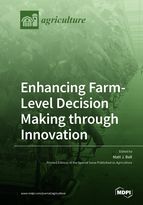Enhancing Farm-Level Decision Making through Innovation
A special issue of Agriculture (ISSN 2077-0472). This special issue belongs to the section "Agricultural Systems and Management".
Deadline for manuscript submissions: closed (25 November 2021) | Viewed by 18276
Special Issue Editor
Interests: farming systems; innovation; environmental impact; animal-plant interactions; sustainable production
Special Issues, Collections and Topics in MDPI journals
Special Issue Information
Dear Colleagues,
New information and knowledge are important aspects of innovation in modern farming systems. There is currently an abundance of digital and data-driven solutions that can potentially transform our food systems. At a time when the general public has concerns about how food is produced and the impact of farm production systems on the environment, strategies to increase public acceptance and the sustainability of food production are required more than ever. New tools and technology can provide timely insights into aspects such as nutrient profiles, tracking of animal or plant wellbeing, and land use options to enhance inputs and outputs associated with the farm business. Such solutions have the ultimate aim to enhance efficiencies of production and contribute to the process of learning about the advantages of the innovation, while ensuring more sustainable food supplies. At the farm level, any new information needs to be in a useful format and beneficial for management and farm decision making. We welcome papers to this Special Issue on studies investigating agri-business innovation that can enhance farm-level decision making.
Prof. Dr. Matt J. Bell
Guest Editor
Manuscript Submission Information
Manuscripts should be submitted online at www.mdpi.com by registering and logging in to this website. Once you are registered, click here to go to the submission form. Manuscripts can be submitted until the deadline. All submissions that pass pre-check are peer-reviewed. Accepted papers will be published continuously in the journal (as soon as accepted) and will be listed together on the special issue website. Research articles, review articles as well as short communications are invited. For planned papers, a title and short abstract (about 100 words) can be sent to the Editorial Office for announcement on this website.
Submitted manuscripts should not have been published previously, nor be under consideration for publication elsewhere (except conference proceedings papers). All manuscripts are thoroughly refereed through a single-blind peer-review process. A guide for authors and other relevant information for submission of manuscripts is available on the Instructions for Authors page. Agriculture is an international peer-reviewed open access monthly journal published by MDPI.
Please visit the Instructions for Authors page before submitting a manuscript. The Article Processing Charge (APC) for publication in this open access journal is 2600 CHF (Swiss Francs). Submitted papers should be well formatted and use good English. Authors may use MDPI's English editing service prior to publication or during author revisions.
Keywords
- smart systems
- precision farming
- digital solutions
- Big Data
- agri-business
- innovation
- decision making
- knowledge and information sources
- sustainability
- management






